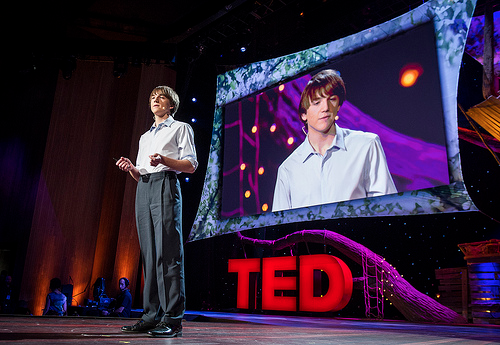March 19, 2013
How to Foster Your Child’s Unique Gifts
If there is one thing attending TED 2013 proved, it is this: no matter how young or how old we are, we all have unique gifts and talents. When 16-year-old Jack Andraka took the stage, I was impressed by this young man’s ability to develop an early detector for pancreatic cancer. I wondered: what sort of encouragement must this child have received at home to dogmatically pursue lab access from 200 different professors before finally receiving a positive reply from Dr. Anirban Maitra of Johns Hopkins School of Medicine?
Andraka’s mother once told the Baltimore Sun, “…we’re not a super athletic family. We don’t go to much football or baseball. Instead we have a million (science) magazines and sit around the table and talk about how people came up with their ideas and what we would do differently.”
This sort of encouragement follows the Discovery Learning Model. Discovery Learning is a way of exploring concepts in order to develop new ideas and new models of thinking and behavior. Instead of being given concrete answers, children learn by trying and discarding; they learn through investigating options and discussing possibilities.
For example, when my children were young, my husband would drive a different route to school each day. This simple activity showed my children that there was more than one way to solve a problem. Andraka’s family, by providing a print-rich environment with exposure to science books and magazines, created easy access to exploration and experimentation.
While your child may not necessarily develop a medical breakthrough as Andraka did, encouraging your child with activities that support the Discovery Learning Model can help foster the discovery of their unique gifts and talents.
Here are six simple ways you can incorporate the Discovery Learning Model into your family life today:
- After school, ask your child to share one thing they enjoyed about their day. What surprised them about that one thing? How did they feel about it?
- The next time you read a book to your elementary school age and younger children, pause and ask them what they think will happen next, or how they think a character is feeling or what a character is thinking at that moment.
- When your child is faced with a problem that has them stumped, do not give them a definite answer, but instead ask questions such as “what would happen if you chose Path A versus Path B? How would that choice make you feel?”
- If a toy or machine breaks in the house, ask your children to help come up with different solutions to fix it.
- Have your child(ren) cook dinner and allow them to decide what to cook, what ingredients to use, and how the meal should be prepared. When your child asks a question about the proper way to cook something, respond with another question that helps them figure out the answer on their own.
- Let your child experiment with different creative opportunities without judgment or commitment. For example if your child is interested in trying a new musical instrument, rent the instrument instead of buying it. Another example is visiting your local interactive museums, such as the Museum of Science in Boston. Childhood is a time for creative play, and children must test themselves against their environment without formal instruction or constraint.
The Discovery Learning Model is a simple, yet effective way of engaging your child’s brain in a thoughtful way. By encouraging your child to seek out answers, tap into their innate curiosity, removing the roadblocks of what is correct and incorrect, you allow room in your child’s brain for the associations that stimulate creativity and innovation. This can lead to amazing discoveries of your child’s unique gifts and talents that might otherwise never have come to the forefront.
(image source: flickr/TedConference)
Filed Under: Blog, Education, Parenting & Family
Tagged With: discovery learning model, TED













